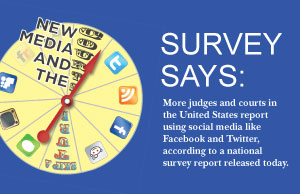More Judges Using Facebook and Twitter Nationally

Survey reveals how social media and broader changes in the media industry are impacting state and local judges and courts.

Survey reveals how social media and broader changes in the media industry are impacting state and local judges and courts.
More judges and courts in the United States report using social media like Facebook and Twitter, according to a national survey report released today.
The 2012 CCPIO New Media and the Courts Survey gives the judicial community in the United States its first year-to-year comparison spanning three years of data unraveling how social media and broader changes in the media industry are impacting state and local judges and courts.
The report contains several major conclusions:
- The participation of judges in the survey continued to climb, as did their use of the technologies surveyed.
- The percentage of judges who strongly agree that their own use of the technologies in the survey poses no threat to professional ethics has doubled since the first year of the survey. This applies whether the technologies are used in personal or professional lives.
- The percentage of judges who strongly agree that courts as institutions can use the technology without compromising ethics has also doubled since 2010.
- The percentage of judges who strongly agree that new media are necessary for public outreach has doubled since 2010.
The survey was conducted by the Conference of Court Public Information Officers, an organization of more than 100 communications professionals working in state and federal courts in the United States and worldwide. Partners in the project include the National Center for State Courts in Williamsburg, Va., the nation’s leading center for research assistance to the country’s state court systems, and the E.W. Scripps School of Journalism at Ohio University.
The survey findings are part of a national collaborative research project now entering its fourth year, which for the first time measured the impact of new media on the courts, and identified the cautious approach courts have taken toward new media out of concern for possible adverse effects on professional ethics and court proceedings while identifying the opportunities these new communication tools afford the judicial system to enhance public understanding of the courts.
The complete project report, “2012 CCPIO New Media Survey, New Media and the Courts: The Current Status and A Look at the Future” is available on the CCPIO website at www.ccpio.org.
More than 15,000 individuals in the court community were invited to participate in the electronically distributed survey. Of the 623 individuals who completed the survey, 238, or 45.6 percent were judges, magistrates or other hearing officers, up 12 percent from the 2011 survey. The majority of the respondents were court system staff.
“The research reflects the high importance judges and courts place on understanding social media technologies and the impact they are having inside and out of courthouses across the nation,” said Thomas Hodson Director of the E.W. Scripps School of Journalism at Ohio University. “Judiciaries’ increased drive to support transparent courts and an informed citizenry through outreach and transparency has shifted court’s focus to methodically experiment with these technologies.”
Survey results explore use rates by court personnel and courts as institutions of social media profile sites like Facebook, microblogging services like Twitter and visual media sharing sites like YouTube.


